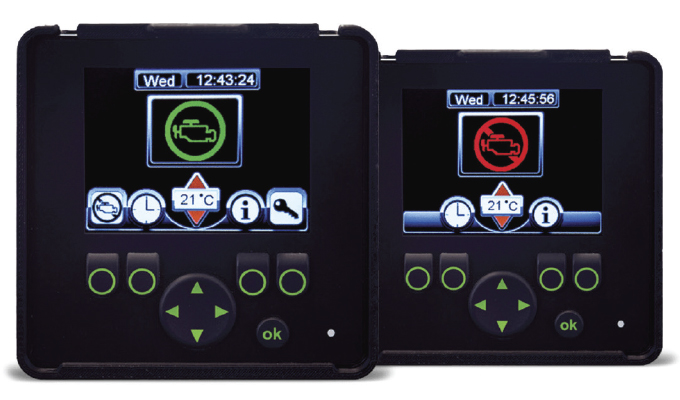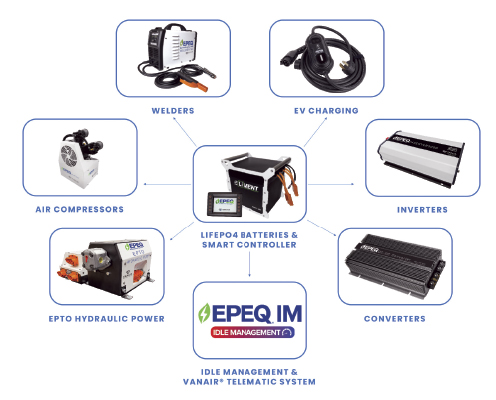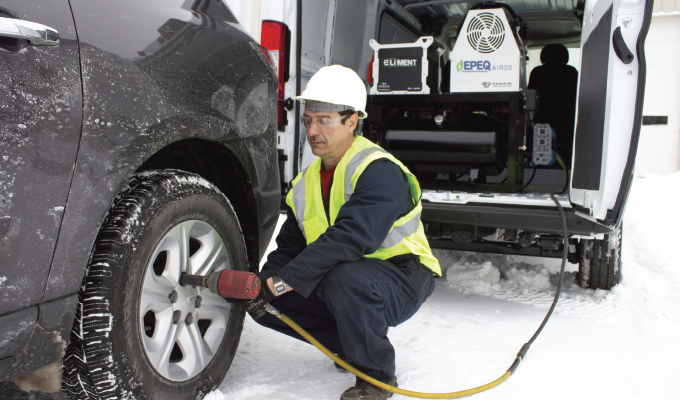Idle mitigation is fast becoming a hot topic among today’s commercial fleets. Work truck fleets are increasingly focused on reducing or eliminating the amount of time their vehicles spend idling or running while not in motion.
Whether a fleet’s goal is to meet tightening idling regulations, reduce engine wear, minimize maintenance intervals, maximize vehicle lifespans, or to make good on commitments to corporate social responsibility promises, idle mitigation is playing an increasingly pivotal role in the decision-making process. A key issue for these fleets is how they can maintain their current levels of productivity within the constraints of new environments while limiting or significantly reducing vehicle idling.
Many fleets are also cautiously eyeing the impending switch from internal combustion engines (ICE) to electric vehicles (EV). Many wonder if EV replacement vehicles will be available and ready in time. Most have concerns about whether their EVs will have sufficient power to travel to the job site, complete the necessary tasks, and return to their base of operation.
“Fleets are navigating through a quickly evolving business landscape with numerous factors at play,” says Dean Strathman, vice president of sales, Vanair. “With over 50 years of service in the mobile power market, we have supported fleets through various changes. However, the pace of change we’re seeing now is unprecedented in our experience.”
Strathman highlighted that Vanair maintains strong communication with its customers across a wide swath of industries. Thanks to its comprehensive voice-of-the-customer (VOC) program, which ensures a steady flow of feedback from real-world experiences, Vanair was able to see the need for idle mitigation solutions well before the trend was on others’ radars.

EPEQ SAGA
In 2021, Vanair launched its EPEQ Electrified Power Equipment (EPEQ) line, an expansion of the company’s range of products, known as its “Mobile Power Solutions.” The EPEQ series is an all-encompassing, patent-pending system that provides all the necessary components for a full green technology solution. Designed to offer practical electric mobile power options for today, the EPEQ lineup enables any fleet to lower its fuel consumption, carbon emissions and comply with or exceed almost all state, county, and local idling regulations.
The EPEQ line features an array of fully electric mobile power solutions that can reduce a fleet’s CO2 emissions. “With our offerings, fleets can now shut off their trucks on-site, adhere to all regulations, and crucially, still accomplish their tasks,” says Strathman.
EPEQ is scalable with the ELiMENT brand lithium iron phosphate battery as the heart of the EPEQ ecosystem, which Includes welders, air compressors, EPTO hydraulic power, converters, inverters, and EV charging capabilities.
In 2023, Vanair unveiled the EPEQ IM Idle Management system. The system can be customized to turn the vehicle on or off based on fleet-defined parameters, such as run time or battery state of charge. It utilizes the onboard vehicle battery or its ELiMENT LiFePO4 auxiliary battery to power various functions, including cab heat and air conditioning, emergency lights, radios, laptops, cameras, and AC electrical equipment.
The system’s “smart controller” unit is installed under the dash and links up with the vehicle’s J1939 CAN bus network or OBD port. The EPEQ IM system is designed to automatically shut off the vehicle once it meets predetermined conditions, effectively cutting down on idling time, or ghost miles, which contribute to vehicle wear and tear. The decrease in idling saves on maintenance costs through less fuel use, fewer engine hours, and lower frequency of DPF regeneration and cleaning, but also tackles emissions issues and prolongs the service life of the chassis.
“Vanair also provides telematics features, delivering crucial data on asset usage to fleet managers,” says Strathman. “This advanced telematics suite allows for detailed tracking of multiple factors such as, connected equipment including total run time, battery conditioning and utilization, component condition and usage, fuel savings and CO2 reduction. Armed with this data, fleet managers are better positioned to make strategic fleet investment decisions, enhance asset deployment, and pinpoint parts that could be eliminated to reduce space and weight.”
FAILURE RATE MOTIVATOR
One Midwest-based, heavy construction fleet that does a lot of idling in the field, reported that it had “burned-up” several gasoline engines. They were frustrated by the failure rate and felt like they had to find a solution that would help keep their remaining vehicles, and potentially new replacement vehicles, in service for a more reasonable length of time.
“They asked for a quote on multiple vehicles to start with,” says Strathman. “And they plan on ordering more, once they have a chance to see them perform.”
CONTROL MOTIVATOR
A large Southwest-based heavy construction equipment dealership has an equally large contingent of service trucks that they use to support both their customers who purchase and rent their equipment.
“Years ago, there was a trend in the marketplace to put auxiliary power equipment of some sort on work trucks and eliminate PTOs,” says Strathman. “This fleet decided that they would start using APUs, including Vanair’s PowerFlex Series and Air N Arc Series auxiliary power units, all in an effort to reduce idle time and extend chassis life.”
Strathman went on to explain that their fleet vehicles are equipped with telematics and that when the fleet pulled reports for its 500 service vehicles, they noticed an interesting trend. When they compared the idling times between the PTO-driven vehicle with those with auxiliary power units, there was no difference in idling time.
They realized that an extenuating circumstance was the warm weather in the lower elevations and cold weather in the upper elevations and that the workers were idling the vehicles to run their HVAC systems. Unfortunately, in the process of staying comfortable, nullifying the anticipated benefit of moving to auxiliary power units.
“This fleet is thrilled that Vanair’s EPEQ IM can circumvent worker behaviors, while keeping those same workers safe, comfortable and happy by providing them with auxiliary AC and heat, not to mention power for safety lighting, radios, and AC power for computers and other electrical equipment,” says Strathman.

SUPPLY SIDE MOTIVATOR
A large customer has an aggressive growth strategy, with their business model working well for them, and they are growing organically through acquisition. With the shortages and backlogs in vehicle delivery that are still plaguing the industry, they are finding that they just can’t get the volume of vehicles to keep up with their growth trajectory targets. Therefore, part of their strategy is to be able to extend the life of their existing chassis and they’re looking at idle management as a solution.
“They’re just dealing with the reality that they’re not going to be able to get the new chassis they want, so they need to make the ones they’ve got last a lot longer by adding our EPEQ IM System,” says Strathman.
CORPORATE CITIZENSHIP
For large organizations, particularly utilities and publicly traded entities, some of the common motivating factors surrounding idle mitigation are still applicable but are not necessarily the top driving factor in adoption. In the C-suite, attention often turns to the goals and objectives the company has publicly committed to and these often include CO2 emission reductions.
“If our standard solution cuts idle reduction by 60 to 70 percent, the executives I encounter around the boardroom table often ask what the impact of adding another EPEQ ELiMENT LiFePO4 auxiliary battery would be,” says Strathman. “They want the maximum amount of CO2 reduction possible.”
Strathman also highlighted an additional advantage for publicity-conscious boards of directors. He explained that with the EPEQ system, these fleets don’t have to wait for the conversion to EV to take place, they can reap significant emissions reduction benefits immediately with their existing ICE vehicles.
GRIP ON THE FUTURE
In January 2024, Vanair announced the acquisition of Grip Idle Management, a company recognized for its patented and leading technology in advanced vehicle engine idle reduction. Grip’s cutting-edge technology integrates with Vanair’s existing EPEQ IM system.
FOR MORE INFORMATION
To learn more about Vanair and its EPEQ Idle Management System, visit www.vanair.com.




